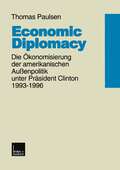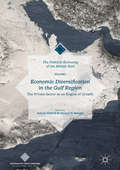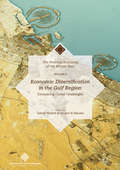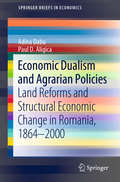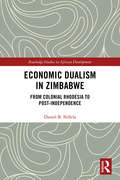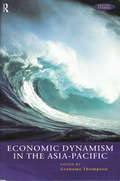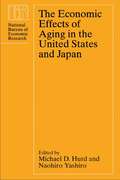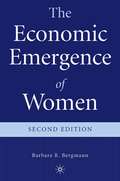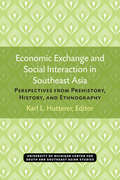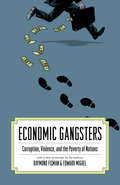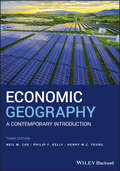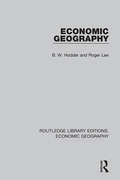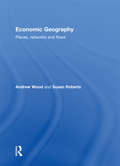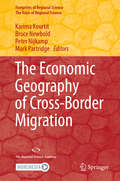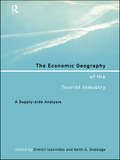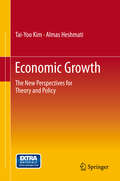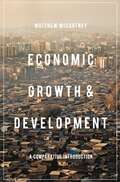- Table View
- List View
Economic Diplomacy: Die Ökonomisierung der amerikanischen Außenpolitik unter Präsident Clinton 1993–1996
by Thomas Paulsen"It's the economy, stupid!" - das war der innenpolitische Slogan, mit dem Bill Clinton 1992 die Wähler für sich gewinnen konnte. Auch in der Außenpolitik erhob der neue Präsident den Anspruch, das Verhältnis zwischen sicherheits- und wirtschaftpolitischen Prioritäten neu zu ordnen. Ökonomische Ziele sollten von nun an den Kern des außenpolitischen Interessenkalküls der USA bilden. "Economic Diplomacy" wurde zum Leitbild einer neuen Außenpolitik erhoben, nationale Sicherheit als ökonomische Sicherheit neu definiert. Das Buch untersucht, ob hinter dem Label "Economic Diplomacy" tatsächlich ein solch fundamentaler Wandel der amerikanischen Außenpolitik steht. Drei Fragen stehen im Mittelpunkt: Welches waren die Grundzüge der außenpolitischen Agenda Clintons? Was waren die Ideen und Wahrnehmungsmuster hinter dem Konzept der "Economic Diplomacy"? Inwieweit konnte Clinton seine Vorstellungen im außenpolitischen Entscheidungsprozeß und in der operativen Außenpolitik in die Praxis umsetzen?
Economic Diversification in the Gulf Region, Volume I: The Private Sector as an Engine of Growth
by Ashraf Mishrif Yousuf Al BalushiThis volume focuses on the role of the private sector in diversifying the economics of Gulf countries in the post-petrodollar era, when fluctuating and declining oil prices are negatively impacting national expenditures. It explores current policies of countries in the Gulf Cooperation Council and their efforts to shift their economies away from heavy dependence on hydrocarbons. The structural changes will create favorable conditions for the private sector to flourish, shift production dependence from public to private sector, and allow for more efficient resource allocation. Such changes will also allow local banks to provide financial support to small and medium enterprises, boost entrepreneurship for job creation, and strengthen organizational structure and efficiency. This is the first volume in Economic Diversification in the Gulf Region.
Economic Diversification in the Gulf Region, Volume I: The Private Sector as an Engine of Growth
by Ashraf Mishrif Yousuf Al BalushiThis volume focuses on the role of the private sector in diversifying the economics of Gulf countries in the post-petrodollar era, when fluctuating and declining oil prices are negatively impacting national expenditures. It explores current policies of countries in the Gulf Cooperation Council and their efforts to shift their economies away from heavy dependence on hydrocarbons. The structural changes will create favorable conditions for the private sector to flourish, shift production dependence from public to private sector, and allow for more efficient resource allocation. Such changes will also allow local banks to provide financial support to small and medium enterprises, boost entrepreneurship for job creation, and strengthen organizational structure and efficiency. This is the first volume in Economic Diversification in the Gulf Region.
Economic Diversification in the Gulf Region, Volume II: Comparing Global Challenges
by Ashraf Mishrif Yousuf Al BalushiThis volume explores the challenges to diversification in Gulf countries, which can no longer rely on profits from hydrocarbons to fund national expenditures. It elaborates on the problem of weak institutions, lack of coordination between policy makers and executors, limited investment in research and development, and a workforce that is too poorly skilled to compete in the private sector. In addition to analyzing issues in areas such as education, labor, business, and trade, the contributors underscore the importance of using global best practices to overcome fundamental weaknesses in the Gulf Cooperative Council's economic structure that limit opportunities for economic diversification.This is the second volume in Economic Diversification in the Gulf Region.
Economic Diversification in the Gulf Region, Volume II: Comparing Global Challenges
by Ashraf Mishrif Yousuf Al BalushiThis volume explores the challenges to diversification in Gulf countries, which can no longer rely on profits from hydrocarbons to fund national expenditures. It elaborates on the problem of weak institutions, lack of coordination between policy makers and executors, limited investment in research and development, and a workforce that is too poorly skilled to compete in the private sector. In addition to analyzing issues in areas such as education, labor, business, and trade, the contributors underscore the importance of using global best practices to overcome fundamental weaknesses in the Gulf Cooperative Council's economic structure that limit opportunities for economic diversification.This is the second volume in Economic Diversification in the Gulf Region.
Economic Dualism and Agrarian Policies: Land Reforms and Structural Economic Change in Romania, 1864–2000 (SpringerBriefs in Economics)
by Adina Dabu Paul D. AligicaThis book offers an in-depth case study of Romania’s land and agricultural reforms from mid-19th century and up to 2000, offering a historical account of agricultural reforms in post-communist Romania in the light of more than a century of social and economic development experiments. Taking a ‘dual economy’ analytic perspective, the book examines the impact of structural and agricultural reforms on the country's economic development and provides an analysis of the ideas and models that stood behind policy reforms aiming at the modernization of an economy and society defined by dualism and late development.
Economic Dualism in Zimbabwe: From Colonial Rhodesia to Post-Independence (Routledge Studies in African Development)
by Daniel B. NdlelaThis book identifies the root causes of income inequality in underdeveloped economies and proposes new solutions for structural reform in economies that have long neglected and exploited working people. It focuses on the case of Zimbabwe, a classic example of an African post-colonial state continuing with dualistic economic structures while simultaneously laying the blame for the initiation of this form of underdevelopment with colonialism. The book explores the colonial roots of economic dualism, in which traditional sectors run alongside newer forms of wage employment, and suggests ways for Zimbabwe to move beyond the ingrained inequalities and asymmetries in production and organisation that it generates. Using a combination of theoretical and empirical approaches, Economic Dualism in Zimbabwe demonstrates how economic dualism can be eliminated through structural transformation of the traditional agricultural sector and reallocation of labour across sectors. The author comprehensively discusses the origins of dualism in Zimbabwe, how it developed in land, labour, credit and financial markets, who stands to gain and lose from it, and ultimately what reforms are needed to eliminate dualism from the economic system. The book aims to complement efforts made by both North and South to transform this structurally embedded cause of underdevelopment and seeks to motivate change in the collective development agenda mindset. This book will be of interest to graduate-level students, scholars, researchers and policy practitioners in the fields of Development Studies, Economics, Agricultural Policy, Labour Policy, Economic Planning and African Studies.
Economic Dualism in Zimbabwe: From Colonial Rhodesia to Post-Independence (Routledge Studies in African Development)
by Daniel B. NdlelaThis book identifies the root causes of income inequality in underdeveloped economies and proposes new solutions for structural reform in economies that have long neglected and exploited working people. It focuses on the case of Zimbabwe, a classic example of an African post-colonial state continuing with dualistic economic structures while simultaneously laying the blame for the initiation of this form of underdevelopment with colonialism. The book explores the colonial roots of economic dualism, in which traditional sectors run alongside newer forms of wage employment, and suggests ways for Zimbabwe to move beyond the ingrained inequalities and asymmetries in production and organisation that it generates. Using a combination of theoretical and empirical approaches, Economic Dualism in Zimbabwe demonstrates how economic dualism can be eliminated through structural transformation of the traditional agricultural sector and reallocation of labour across sectors. The author comprehensively discusses the origins of dualism in Zimbabwe, how it developed in land, labour, credit and financial markets, who stands to gain and lose from it, and ultimately what reforms are needed to eliminate dualism from the economic system. The book aims to complement efforts made by both North and South to transform this structurally embedded cause of underdevelopment and seeks to motivate change in the collective development agenda mindset. This book will be of interest to graduate-level students, scholars, researchers and policy practitioners in the fields of Development Studies, Economics, Agricultural Policy, Labour Policy, Economic Planning and African Studies.
Economic Dynamism in the Asia-Pacific: The Growth of Integration and Competitiveness
by Grahame ThompsonThis broad-ranging student textbook examines the rise of the Asia-Pacific as an important economic region. It looks at the sources of that rise, its future development and the possible consequences for the global economy. The analysis is divided into three sections considering:* how far the Asia-Pacific has developed as a regional system, looking at the patterns of integration of the principal economies* the relationship between the key individual economies of Japan, Korea, China and the United States* how the rise of the Asia-Pacific economy has affected the international economic system.In so doing it provides much-needed insights not only into the growth of this powerful economic region, but also the international context of Asia-Pacific development.
Economic Dynamism in the Asia-Pacific: The Growth of Integration and Competitiveness
by Grahame ThompsonThis broad-ranging student textbook examines the rise of the Asia-Pacific as an important economic region. It looks at the sources of that rise, its future development and the possible consequences for the global economy. The analysis is divided into three sections considering:* how far the Asia-Pacific has developed as a regional system, looking at the patterns of integration of the principal economies* the relationship between the key individual economies of Japan, Korea, China and the United States* how the rise of the Asia-Pacific economy has affected the international economic system.In so doing it provides much-needed insights not only into the growth of this powerful economic region, but also the international context of Asia-Pacific development.
The Economic Effects of Aging in the United States and Japan (National Bureau of Economic Research Project Report)
by Michael D. Hurd Naohiro YashiroDue to falling fertility rates, the aging of the baby-boom cohort, and increases in life expectancy, the percentage of the population that is elderly is expected to increase rapidly in the United States and Japan over the next two decades. These fourteen essays show that, despite differences in culture and social and government structure, population aging will have many similar macro and micro effects on the economic status and behavior of the elderly in both countries. The most obvious effects will be on social programs such as public pension systems and the provision for medical needs of the elderly. But, the contributors demonstrate, aging will also affect markets for labor, capital, housing, and health care services. It will affect firms through their participation in the demand side of the labor market and through their provisions for pensions. And aging will influence saving rates, the rate of return on assets, the balance of payments, and, most likely, economic growth. This volume will interest scholars and policy makers concerned with the economics of aging.
The Economic Emergence of Women
by B. BergmannThis new edition of a classic feminist book explains how one of the great historical revolutions - the ongoing movement toward equality between the sexes - has come about. Its origins are to be found, not in changing ideas, but in the economic developments that have made women's labour too valuable to be spent exclusively in domestic pursuits. The revolution is unfinished; new arrangements are needed to fight still-prevalent discrimination in the workplace, to achieve a more just sharing of housework and childcare between women and men, and, with the weakening of the institution of marriage, to re-erect a firm economic basis for the raising of children.
Economic Exchange and Social Interaction in Southeast Asia: Perspectives from Prehistory, History, and Ethnography (Michigan Papers On South And Southeast Asia #13)
by Karl L. HuttererEconomic behavior is governed by two major sets of boundary conditions: environmental and technological factors on the one hand, and conditions of social organization on the other hand. Indeed, social scientists are often particularly interested in the framework of exchange relationships: exchange of goods, services, personnel, and information. Economic exchanges lend concrete manifestations to social relations that themselves may transcend the economic realm and that otherwise are often difficult to trace. Yet in social science research in Southeast Asia, the area of economic studies has lagged behind, despite the great study potential represented by the tremendous diversity of its physical and human environment. Economic Exchange and Social Interaction in Southeast Asia attempts to take advantage of that opportunity. As a number of the contributions to this volume show, many if not most of the systems organized on very different levels of integration interact with each other. Taken as a whole, they provide evidence of the incredible diversity of economic and social systems that may be investigated in Southeast Asia.
Economic Gangsters: Corruption, Violence, and the Poverty of Nations
by Ray Fisman Edward MiguelMeet the economic gangster. He's the United Nations diplomat who double-parks his Mercedes on New York City streets at rush hour because the cops can't touch him--he has diplomatic immunity. He's the Chinese smuggler who dodges tariffs by magically transforming frozen chickens into frozen turkeys. The dictator, the warlord, the unscrupulous bureaucrat who bilks the developing world of billions in aid. The calculating crook who views stealing and murder as just another part of his business strategy. And, in the wrong set of circumstances, he might just be you. In Economic Gangsters, Raymond Fisman and Edward Miguel take readers into the secretive, chaotic, and brutal worlds inhabited by these lawless and violent thugs. Join these two sleuthing economists as they follow the foreign aid money trail into the grasping hands of corrupt governments and shady underworld characters. Spend time with ingenious black marketeers as they game the international system. Follow the steep rise and fall of stock prices of companies with unseemly connections to Indonesia's former dictator. See for yourself what rainfall has to do with witch killings in Tanzania--and more. Fisman and Miguel use economics to get inside the heads of these "gangsters," and propose solutions that can make a difference to the world's poor--including cash infusions to defuse violence in times of drought, and steering the World Bank away from aid programs most susceptible to corruption. In a new postscript, the authors look at how economists might use new tools to better understand, and fight back against, corruption and violence in the aftermath of the 2008 financial crisis. Take an entertaining walk on the dark side of global economic development with Economic Gangsters.
Economic Gangsters: Corruption, Violence, and the Poverty of Nations
by Ray Fisman Edward MiguelMeet the economic gangster. He's the United Nations diplomat who double-parks his Mercedes on New York City streets at rush hour because the cops can't touch him--he has diplomatic immunity. He's the Chinese smuggler who dodges tariffs by magically transforming frozen chickens into frozen turkeys. The dictator, the warlord, the unscrupulous bureaucrat who bilks the developing world of billions in aid. The calculating crook who views stealing and murder as just another part of his business strategy. And, in the wrong set of circumstances, he might just be you. In Economic Gangsters, Raymond Fisman and Edward Miguel take readers into the secretive, chaotic, and brutal worlds inhabited by these lawless and violent thugs. Join these two sleuthing economists as they follow the foreign aid money trail into the grasping hands of corrupt governments and shady underworld characters. Spend time with ingenious black marketeers as they game the international system. Follow the steep rise and fall of stock prices of companies with unseemly connections to Indonesia's former dictator. See for yourself what rainfall has to do with witch killings in Tanzania--and more. Fisman and Miguel use economics to get inside the heads of these "gangsters," and propose solutions that can make a difference to the world's poor--including cash infusions to defuse violence in times of drought, and steering the World Bank away from aid programs most susceptible to corruption. In a new postscript, the authors look at how economists might use new tools to better understand, and fight back against, corruption and violence in the aftermath of the 2008 financial crisis. Take an entertaining walk on the dark side of global economic development with Economic Gangsters.
Economic Geography: A Contemporary Introduction
by Neil M. Coe Philip F. Kelly Henry W. YeungA revised and updated edition of the leading introductory text on the geography of economic life, from the local to the global Economic Geography is an engaging and accessible introduction to the different ways modern economic geographers understand, analyze, and interpret economic processes. This comprehensive text addresses significant questions relevant to contemporary economic life, from the activities of transnational corporations to issues surrounding workplaces and consumption. It encourages readers to explore how spatial patterns, places, networks, and territories shape large-scale economic processes. Accessible, highly-illustrated material presents fresh insights from the field—complemented by relatable, real-world examples that help students understand the social, cultural, and political contexts underpinning global economic processes. Now in its third edition, this extensively revised and updated textbook retains the features and thematic structure that have proved popular with students and instructors alike, while adding exciting new content. New chapters explore how the global economy and global development are institutionalized and governed, the economic geographies of global climate change, economic practices outside the capitalist mainstream, the role of migrants in labour markets, global production networks, and more. Introduces economic geography with a thematic approach including major concepts, current debates, and case studies Revised and updated to enhance international coverage, including three entirely new chapters on international development, alternative economies, and global climate change Substantial new content on labour migration, global production networks, and recent intellectual trends such as evolutionary economic geography Highly illustrated with diagrams and photographs closely integrated into the text Pedagogical aids including key case studies, learning objectives, text boxes, chapter essay questions, summaries, and further reading Core geographical concepts – such as place, networks and territory – are closely integrated into all chapters. Economic Geography: A Contemporary Introduction is an invaluable source of up-to-date knowledge for students new to the field, for those requiring a solid foundation, as well as for a broader academic and public readership with interest in this area of study.
Economic Geography (Routledge Library Editions: Economic Geography)
by Roger Lee B. W. HodderThis book introduces the reader to the many lines of thought in the literature on economic geography and ties these various aspects together within the concept of the economy. The book focusses on the dynamic and integrated nature of economies at different scales and levels of development. Emphasis is laid on the processes at work within economies. The authors discuss the concept of the economy, helping both to clarify the nature of economic activity and to reveal the importance and sources of economic power as the underlying means of control in economies. They also demonstrate that the operation of an economy and the distribution of economic power are critical influences on many other, apparently non-economic, aspects of human existence.
Economic Geography: Alternative Economic And Political Spaces (Routledge Library Editions: Economic Geography)
by Roger Lee B. W. HodderThis book introduces the reader to the many lines of thought in the literature on economic geography and ties these various aspects together within the concept of the economy. The book focusses on the dynamic and integrated nature of economies at different scales and levels of development. Emphasis is laid on the processes at work within economies. The authors discuss the concept of the economy, helping both to clarify the nature of economic activity and to reveal the importance and sources of economic power as the underlying means of control in economies. They also demonstrate that the operation of an economy and the distribution of economic power are critical influences on many other, apparently non-economic, aspects of human existence.
Economic Geography: Places, Networks and Flows
by Andrew Wood Susan RobertsThe turbulence of the current times has dramatically transformed the world’s economic geographies. The scale and scope of such changes require urgent attention. With intellectual roots dating to the nineteenth century, economic geography has traditionally sought to examine the spatial distributions of economic activity and the principles that account for them. More recently, the field has turned its attention to a range of questions relating to: globalization and its impact on different peoples and places; economic inequalities at different geographic scales; the development of the knowledge-based economy; and the relationship between economy and environment. Now, more than ever, the changing fortunes of peoples and places demands our attention. Economic Geography provides a stimulating and innovative introduction to economic geography by establishing the substantive concerns of economic geographers, the methods deployed to study them, the key concepts and theories that animate the field, and the major issues generating debate. This book is the first to address the diverse approaches to economic geography as well as the constantly shifting economic geographies on the ground. It encompasses traditional approaches, albeit from a critical perspective, while providing a thorough, accessible and engaging examination of the concerns, methods and approaches of the ‘new economic geography’. This unique introductory text covers the breadth of economic geography while engaging with a range of contemporary debates at the cutting-edge of the field. Written in an accessible and lucid style, this book offers a thorough and systematic introductory survey. It is enhanced by pedagogical features throughout including case studies dealing with topics ranging from the head office locations of the Fortune 500, Mexico’s maquiladoras to China’s investments in Southern Africa. This book also contains exercises based on the key concepts and annotated further reading and websites.
Economic Geography: Places, Networks and Flows
by Andrew Wood Susan RobertsThe turbulence of the current times has dramatically transformed the world’s economic geographies. The scale and scope of such changes require urgent attention. With intellectual roots dating to the nineteenth century, economic geography has traditionally sought to examine the spatial distributions of economic activity and the principles that account for them. More recently, the field has turned its attention to a range of questions relating to: globalization and its impact on different peoples and places; economic inequalities at different geographic scales; the development of the knowledge-based economy; and the relationship between economy and environment. Now, more than ever, the changing fortunes of peoples and places demands our attention. Economic Geography provides a stimulating and innovative introduction to economic geography by establishing the substantive concerns of economic geographers, the methods deployed to study them, the key concepts and theories that animate the field, and the major issues generating debate. This book is the first to address the diverse approaches to economic geography as well as the constantly shifting economic geographies on the ground. It encompasses traditional approaches, albeit from a critical perspective, while providing a thorough, accessible and engaging examination of the concerns, methods and approaches of the ‘new economic geography’. This unique introductory text covers the breadth of economic geography while engaging with a range of contemporary debates at the cutting-edge of the field. Written in an accessible and lucid style, this book offers a thorough and systematic introductory survey. It is enhanced by pedagogical features throughout including case studies dealing with topics ranging from the head office locations of the Fortune 500, Mexico’s maquiladoras to China’s investments in Southern Africa. This book also contains exercises based on the key concepts and annotated further reading and websites.
The Economic Geography of Cross-Border Migration (Footprints of Regional Science)
by Karima Kourtit Bruce Newbold Peter Nijkamp Mark PartridgeThis handbook presents a collection of high-quality, authoritative scientific contributions on cross-border migration, written by a carefully selected group of recognized migration experts from around the globe. In recent years, cross-border migration has become an important and intriguing issue, from both a scientific and policy perspective. In the ‘age of migration’, the volume of cross-border movements of people continues to rise, while the nature of migration flows – in terms of the determinants, length of stay, effects on the sending and host countries, and legal status of migrants – is changing dramatically. Based on a detailed economic-geographical analysis, this handbook studies the motives for cross-border migration, the socio-economic implications for sending countries and regions, the locational choice determinants for cross-border migrants, and the manifold economic-geographic consequences for host countries and regions. Given the complexity of migration decisions and their local or regional impacts, a systematic typology of migrants (motives, legal status, level of education, gender, age, singles or families, etc.) is provided, together with an assessment of push factors in the place of origin and pull factors at the destination. On the basis of a solid analytical framework and reliable empirical evidence, it examines the impacts of emigration for sending areas and of immigration for receiving areas, and provides a comprehensive discussion of the policy dimensions of cross-border migration.
The Economic Geography of the Tourist Industry: A Supply-Side Analysis
by Keith G. Debbage Dimitri IoannidesThe Economic Geography of the Tourist Industry bridges the gap between tourism research and economic geography by bringing together leading academics in geography, planning and tourism. The authors explain tourism's definitions and examine whether tourism can be categorized as an industry. They provide detailed analyses of key sectors, such as tour
The Economic Geography of the Tourist Industry: A Supply-Side Analysis
by Dimitri Ioannides Keith G. DebbageThe Economic Geography of the Tourist Industry bridges the gap between tourism research and economic geography by bringing together leading academics in geography, planning and tourism. The authors explain tourism's definitions and examine whether tourism can be categorized as an industry. They provide detailed analyses of key sectors, such as tour
Economic Growth: The New Perspectives for Theory and Policy (Perspectives On Development In The Middle East And North Africa (mena) Region Ser.)
by Tai-Yoo Kim Almas HeshmatiThis book shows that the existing theories on economic growth have clear limitations in terms of how much they can effectively contribute to actual economic growth. Therefore, this book presents a more effective theory on economic growth for countries and leaders looking to promote economic growth. It is essentially centered around the theory of economic growth and theory of national development, written for agricultural developing countries pursuing industrialization and late-starting industrialized countries pursuing their own development. Nevertheless, it also makes a significant contribution to the very development of human civilization through the growth of developing countries, late-starting industrialized countries and early industrialized countries throughout the world.
Economic Growth and Development: A Comparative Introduction
by Matthew McCartneyWidening economic inequalities across the globe today can be understood as the historical consequences of different drivers of growth. This important new text examines the proximate factors of labour, capital and productivity across a range of countries, as well as deeper explanations, from geographical and cultural factors, to colonialism, institutions and the openness of markets and borders. It considers these variables, their effects on rates of growth, and how differing rates of growth will enhance or constrain a country's development. The author makes the case that long-standing inequalities between countries should be the primary focus for academic study, and that development plans should be produced on a case-by-case basis, reflecting the individual circumstances of countries and regions. Using a wide range of historical and contemporary examples, he highlights the blind spots and assumptions that are liable to compromise the priorities and actions of policy-makers, and provides a route towards effective economic reform and sustained development.
